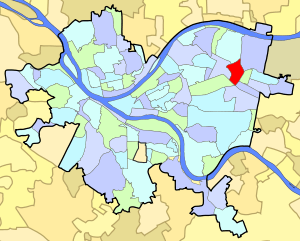Larimer (Pittsburgh)
| Larimer | |
|---|---|
| Neighborhood of Pittsburgh | |
 | |
| Coordinates: 40°27′50″N 79°54′47″W / 40.464°N 79.913°W | |
| Country | United States |
| State | Pennsylvania |
| County | Allegheny County |
| City | Pittsburgh |
| Area[1] | |
| • Total | 0.445 sq mi (1.15 km2) |
| Population (2010)[1] | |
| • Total | 1,728 |
| • Density | 3,900/sq mi (1,500/km2) |
Larimer is a neighborhood in the East End of the City of Pittsburgh, Pennsylvania in the United States. The neighborhood takes its name from William Larimer, who grew up in nearby Westmoreland County and, after making a fortune in the railroad industry, built a manor house overlooking East Liberty along a path that came to be called "Larimer Lane" and later Larimer Avenue.
History
Larimer's daughter, Rachel, married James Mellon, son of Thomas Mellon, which brought what is now Larimer into the Mellon clan's control. As with East Liberty, the Mellons sold or rented this land and used the proceeds to finance Pittsburgh's coal, steel, and gas industries. A number of James Mellon's heirs used Larimer as a middle name, including Gulf Oil founder William Larimer Mellon, and they ensured that the present-day neighborhood took the name as well.
Larimer was originally settled by Germans in the later half of the 19th century. By the early 1900s Italians from Abruzzi, Calabria, Campania, Sicily and Northern Italians became the dominant ethnic group. These settlers were slightly better-off than their kinsmen who moved to Bloomfield around the same time: the residents of Bloomfield built modest frame row-houses, while those in Larimer built somewhat nicer detached brick homes with small yards. Before long, Larimer residents had built and were running concrete foundries and commercial bakeries along Lincoln Avenue towards Two-Mile Run (some of which still exist today), and a successful commercial district at the intersection of Larimer Avenue and Meadow Street, near the community's spiritual home of Our Lady Help of Christians Catholic Church (1898). In 1928, the Italian Sons and Daughters of America was founded in the neighborhood. Larimer was Pittsburgh's Little Italy until the 1960s.
As with other neighborhoods in Pittsburgh's East End, the 1960s were a turning point for Larimer. Some residents began to move to the suburbs in the early part of the decade, and this process was hastened by the urban renewal of East Liberty and the construction of a 320-unit housing project on Larimer Avenue near the entrance to Larimer from East Liberty. Today, aside from a few remaining businesses along Lincoln Avenue, no vestige of the neighborhood's Italian community remains (Our Lady Help of Christians was closed in 1992). The once-proud brick houses are now either abandoned or neglected by absentee landlords, and the residents, largely African-American,[2] are among the poorest in Pittsburgh.[2]
Geography
Larimer is surrounded on nearly all sides by small valleys, or "runs" in the vernacular: branches of Negley Run form a border between Larimer and Highland Park on the North-West, and between Larimer and Lincoln-Lemington on the North-East, while the last bit of Two-Mile Run, the present site of the East Busway, forms a border between Larimer and Homewood on the South-East. On the South-West, there is a natural passage from East Liberty to Larimer along Larimer Avenue.
Housing and Urban Development Grant
In June 2014, Larimer successfully applied for and received a coveted $30 million grant to re-build the neighborhood, which was provided through the US Department of Housing and Development. The grant will provide over 350 units of mixed-income housing. The Mayor of Pittsburgh, William "Bill" Peduto, called the grant, "huge."
 East End Brewing Company, Larimer
East End Brewing Company, Larimer
See also
References
- 1 2 "PGHSNAP 2010 Raw Census Data by Neighborhood". Pittsburgh Department of City Planning PGHSNAP Utility. 2012. Retrieved 24 June 2013. External link in
|publisher=(help) - 1 2 "Census: Pittsburgh" (PDF). Pittsburgh Department of City Planning. January 2006. Retrieved 2007-07-19.